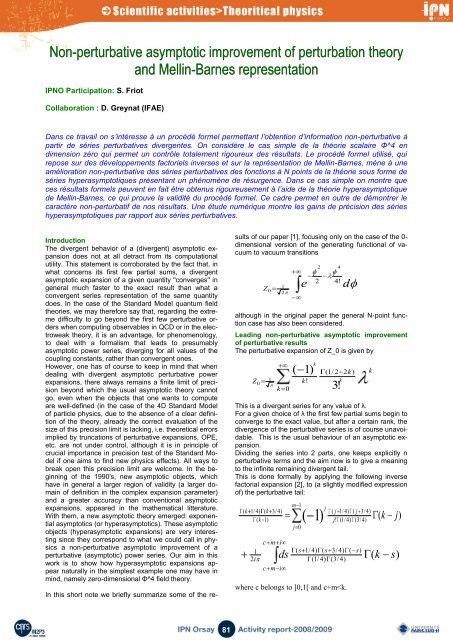exotic nuclei structure and reaction noyaux exotiques ... - IPN - IN2P3
exotic nuclei structure and reaction noyaux exotiques ... - IPN - IN2P3
exotic nuclei structure and reaction noyaux exotiques ... - IPN - IN2P3
You also want an ePaper? Increase the reach of your titles
YUMPU automatically turns print PDFs into web optimized ePapers that Google loves.
Non-perturbative asymptotic improvement of perturbation theory<br />
<strong>and</strong> Mellin-Barnes representation<br />
<strong>IPN</strong>O Participation: S. Friot<br />
Collaboration : D. Greynat (IFAE)<br />
Dans ce travail on s’intéresse à un procédé formel permettant l’obtention d’information non-perturbative à<br />
partir de séries perturbatives divergentes. On considère le cas simple de la théorie scalaire Φ^4 en<br />
dimension zéro qui permet un contrôle totalement rigoureux des résultats. Le procédé formel utilisé, qui<br />
repose sur des développements factoriels inverses et sur la représentation de Mellin-Barnes, mène à une<br />
amélioration non-perturbative des séries perturbatives des fonctions à N points de la théorie sous forme de<br />
séries hyperasymptotiques présentant un phénomène de résurgence. Dans ce cas simple on montre que<br />
ces résultats formels peuvent en fait être obtenus rigoureusement à l’aide de la théorie hyperasymptotique<br />
de Mellin-Barnes, ce qui prouve la validité du procédé formel. Ce cadre permet en outre de démontrer le<br />
caractère non-perturbatif de nos résultats. Une étude numérique montre les gains de précision des séries<br />
hyperasymptotiques par rapport aux séries perturbatives.<br />
Introduction<br />
The divergent behavior of a (divergent) asymptotic expansion<br />
does not at all detract from its computational<br />
utility. This statement is corroborated by the fact that, in<br />
what concerns its first few partial sums, a divergent<br />
asymptotic expansion of a given quantity ''converges'' in<br />
general much faster to the exact result than what a<br />
convergent series representation of the same quantity<br />
does. In the case of the St<strong>and</strong>ard Model quantum field<br />
theories, we may therefore say that, regarding the extreme<br />
difficulty to go beyond the first few perturbative orders<br />
when computing observables in QCD or in the electroweak<br />
theory, it is an advantage, for phenomenology,<br />
to deal with a formalism that leads to presumably<br />
asymptotic power series, diverging for all values of the<br />
coupling constants, rather than convergent ones.<br />
However, one has of course to keep in mind that when<br />
dealing with divergent asymptotic perturbative power<br />
expansions, there always remains a finite limit of precision<br />
beyond which the usual asymptotic theory cannot<br />
go, even when the objects that one wants to compute<br />
are well-defined (in the case of the 4D St<strong>and</strong>ard Model<br />
of particle physics, due to the absence of a clear definition<br />
of the theory, already the correct evaluation of the<br />
size of this precision limit is lacking, i.e. theoretical errors<br />
implied by truncations of perturbative expansions, OPE,<br />
etc. are not under control, although it is in principle of<br />
crucial importance in precision test of the St<strong>and</strong>ard Model<br />
if one aims to find new physics effects). All ways to<br />
break open this precision limit are welcome. In the beginning<br />
of the 1990's, new asymptotic objects, which<br />
have in general a larger region of validity (a larger domain<br />
of definition in the complex expansion parameter)<br />
<strong>and</strong> a greater accuracy than conventional asymptotic<br />
expansions, appeared in the mathematical litterature.<br />
With them, a new asymptotic theory emerged: exponential<br />
asymptotics (or hyperasymptotics). These asymptotic<br />
objects (hyperasymptotic expansions) are very interesting<br />
since they correspond to what we could call in physics<br />
a non-perturbative asymptotic improvement of a<br />
perturbative (asymptotic) power series. Our aim in this<br />
work is to show how hyperasymptotic expansions appear<br />
naturally in the simplest example one may have in<br />
mind, namely zero-dimensional Φ^4 field theory.<br />
sults of our paper [1], focusing only on the case of the 0-<br />
dimensional version of the generating functional of vacuum<br />
to vacuum transitions<br />
Z<br />
0<br />
1<br />
2<br />
e<br />
although in the original paper the general N-point function<br />
case has also been considered.<br />
Leading non-perturbative asymptotic improvement<br />
of perturbative results<br />
The perturbative expansion of Z_0 is given by<br />
Z<br />
0<br />
1<br />
k<br />
This is a divergent series for any value of λ.<br />
For a given choice of λ the first few partial sums begin to<br />
converge to the exact value, but after a certain rank, the<br />
divergence of the perturbative series is of course unavoidable.<br />
This is the usual behaviour of an asymptotic expansion.<br />
Dividing the series into 2 parts, one keeps explicitly n<br />
perturbative terms <strong>and</strong> the aim now is to give a meaning<br />
to the infinite remaining divergent tail.<br />
This is done formally by applying the following inverse<br />
factorial expansion [2], to (a slightly modified expression<br />
of) the perturbative tail:<br />
( k 1/ 4) ( k<br />
( k 1)<br />
3/ 4)<br />
4!<br />
where c belongs to ]0,1[ <strong>and</strong> c+m

















